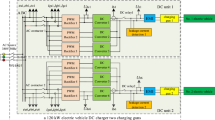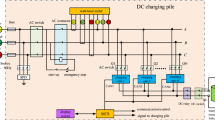Abstract
Pulse-voltage and pulse-current methods are widely used in advanced battery charging systems, because they enhance the overall charging process and prolong the battery lifetime. This paper proposes two battery charging systems for an electric vehicle charging station based on these methods. The first design is a developed version of a studied non-dissipative pulse-current DC–DC stage in which the negative pulse current is generated by a current recirculating block. It employs a precisely designed control system to charge and discharge electric vehicles in a wide range of voltage level. The second design is a pulse-voltage DC–DC stage suggested for high-power applications for the first time based on power electronics circuits. It also attenuates the sudden battery power changes caused by pulse-voltage method. The two designs have been accurately formulated. The practical results with the frequency responses confirm that the two designs work well and have less output power changes compared to the recent relevant works.
















Similar content being viewed by others
References
Yilmaz M, Krein PT (2012) Review of the impact of vehicle-to-grid technologies on distribution systems and utility interfaces. IEEE Trans Power Electron 28(12):5673–5689
Yilmaz M, Krein PT (2013) Review of battery charger topologies, charging power levels, and infrastructure for plug-in electric and hybrid vehicles. IEEE Trans Power Electron 28(5):2151–2169
Liu C, Chau KT, Wu D, Gao S (2013) Opportunities and challenges of vehicle-to-home, vehicle-to-vehicle, and vehicle-to-grid technologies. Proc IEEE 101(11):2409–2427
Gao Y, Zhang X, Cheng Q, Guo B, Yang J (2019) Classification and review of the charging strategies for commercial lithium-ion batteries. IEEE Access 7:43511–43524
Hussein AA-H, Batarseh I (2011) A review of charging algorithms for nickel and lithium battery chargers. IEEE Trans Veh Technol 60(3):830–838
Amanor-Boadu J, Guiseppi-Elie A, Sánchez-Sinencio E (2018) The impact of pulse charging parameters on the life cycle of lithium-ion polymer batteries. Energies 11(8):2162
Chen L-R, Chen J-J, Chu N-Y, Han G-Y (2008) Current-pumped battery charger. IEEE Trans Ind Electron 55(6):2482–2488
Chen L-R, Young C-M, Chu N-Y, Liu C-S (2011) Phase-locked bidirectional converter with pulse charge function for 42-V/14-V dual-voltage power net. IEEE Transn Ind Electron 58(5):2045–2048
Purushothaman BK, Landau U (2006) Rapid charging of lithium-ion batteries using pulsed currents a theoretical analysis. J Electrochem Soc 153(3):A533–A542
Jiang Z, Dougal RA (2004) Synergetic control of power converters for pulse current charging of advanced batteries from a fuel cell power source. IEEE Trans Power Electron 19(4):1140–1150
Chen L-R, Chu N-Y, Wang C-S, Liang R-H (2008) Design of a Reflex-based bidirectional converter with the energy recovery function. IEEE Trans Ind Electron 55(8):3022–3029
Chiu H-J, Lin L-W, Pan P-L, Tseng M-H (2006) A novel rapid charger for lead-acid batteries with energy recovery. IEEE Trans Power Electron 21(3):640–647
Tsai C-T, Kuo Y-C, Kuo Y-P, Hsieh C-T (2015) A Reflex charger with ZVS and non-dissipative cells for photovoltaic energy conversion. Energies 8(2):1373–1389
Yong JY, Ramachandaramurthy VK, Tan KM, Mithulananthan N (2015) A review on the state-of-the-art technologies of electric vehicle, its impacts and prospects. Renew Sustain Energy Rev 49:365–385
Li J, Murphy E, Winnick J, Kohl PA (2001) The effects of pulse charging on cycling characteristics of commercial lithium-ion batteries. J Power Sources 102(1–2):302–309
Monem MA, Trad K, Omar N, Hegazy O, Mantels B, Mulder G, Van den Bossche P, Van Mierlo Joeri (2015) Lithium-ion batteries: evaluation study of different charging methodologies based on aging process. Appl Energy 152:143–155
Hsieh H-I, Tsai C-Y, Hsieh G-C (2014) Photovoltaic burp charge system on energy-saving configuration by smart charge management. IEEE Trans Power Electron 29(4):1777–1790
Bayati M, Abedi M, Hosseinian H, Gharehpetian GB (2017) A novel control strategy for Reflex-based electric vehicle charging station with grid support functionality. J Energy Storage 12:108–120
Chen L-R (2009) Design of duty-varied voltage pulse charger for improving Li-ion battery-charging response. IEEE Trans Ind Electron 56(2):480–487
Chen L-R (2007) A design of an optimal battery pulse charge system by frequency-varied technique. IEEE Trans Ind Electron 54(1):398–405
Yin M, Cho J, Park D (2016) Pulse-based fast battery IoT charger using dynamic frequency and duty control techniques based on multi-sensing of polarization curve. Energies 9(3):209
Amanor-Boadu JM, Abouzied MA, Sánchez-Sinencio E (2018) An efficient and fast Li-ion battery charging system using energy harvesting or conventional sources. IEEE Trans Ind Electron 65(9):7383–7394
Amanor-Boadu JM, Guiseppi-Elie A, Sánchez-Sinencio E (2018) Search for optimal pulse charging parameters for Li-ion polymer batteries using Taguchi orthogonal arrays. IEEE Trans Ind Electron 65(11):8982–8992
Chen L-R, Wu S-L, Shieh D-T, Chen T-R (2013) Sinusoidal-ripple-current charging strategy and optimal charging frequency study for Li-ion batteries. IEEE Trans Ind Electron 60(1):88–97
Chen L-R, Chen J-J, Ho C-M, Wu S-L, Shieh D-T (2013) Improvement of Li-ion battery discharging performance by pulse and sinusoidal current strategies. IEEE Trans Ind Electron 60(12):5620–5628
Cho S-Y, Lee I-O, Baek J-I, Moon G-W (2015) Battery impedance analysis considering DC component in sinusoidal ripple-current charging. IEEE Trans Ind Electron 63(3):1561–1573
Bessman A, Soares R, Vadivelu S, Wallmark O, Svens P, Ekström H, Lindbergh G (2017) Challenging sinusoidal ripple-current charging of lithium-ion batteries. IEEE Trans Ind Electron 65(6):4750–4757
Wang JB, Chuang CY (2007) Design considerations of microprocessor-controlled multiphase battery charger with fast-charging strategy. IET Electr Power Appl 1(2):143–152
Tabari M, Yazdani A (2014) Stability of a DC distribution system for power system integration of plug-in hybrid electric vehicles. IEEE Trans Smart Grid 5(5):2564–2573
Yazdani A, Iravani R (2010) Voltage-Sourced Converters in Power Systems, vol 34. Wiley, New York
Author information
Authors and Affiliations
Corresponding author
Additional information
Publisher's Note
Springer Nature remains neutral with regard to jurisdictional claims in published maps and institutional affiliations.
Rights and permissions
About this article
Cite this article
Bayati, M., Abedi, M., Gharehpetian, G.B. et al. Two designs for DC–DC stage of electric vehicle charging stations. Electr Eng 102, 2389–2399 (2020). https://doi.org/10.1007/s00202-020-01017-3
Received:
Accepted:
Published:
Issue Date:
DOI: https://doi.org/10.1007/s00202-020-01017-3




